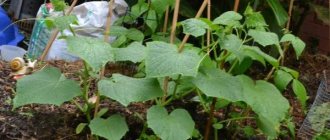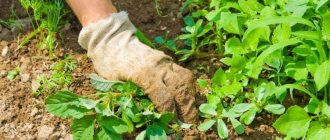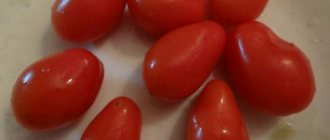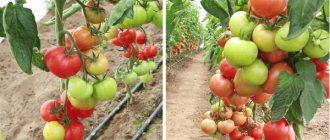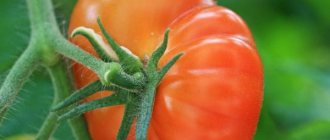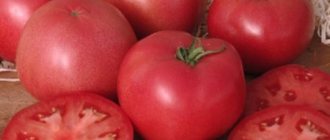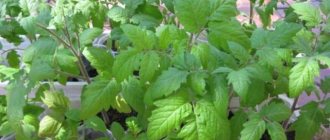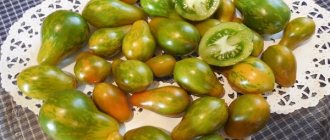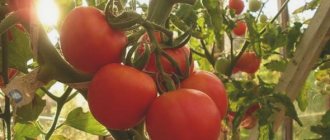Description of the variety
The Maryina Roshcha tomato is an early-ripening hybrid plant; the package with seeds bears the F1 icon. The plant type is indeterminate, that is, the growth of the main stem does not stop throughout the growing season. It should be noted that gardeners who planted these tomatoes respond mostly positively. Now let's look at all the issues in more detail.
Features of the bush
The tomato bush is tall, up to 170 cm in height. It is distinguished by a powerful stem with a large number of branches, which is why it is recommended to plant no more than three plants per square meter. Tomato leaves are dark green, medium in size, regular in shape.
Due to its tall growth and the presence of a large number of stepsons, during the summer the tomato needs to be shaped, cut off excess shoots and leaves, and also tied to a reliable support.
The productivity of the Maryina Roshcha tomato, according to reviews and photos provided by gardeners, is excellent if the bush is formed into 1 or 2 stems.
Fruit
Many clusters with 8 or 9 fruits are formed on the tomato stem. Peduncles are strong, fruit set is excellent. These features of the tomato variety are clearly visible in the photo below.
Each tomato weighs about 170 grams. With proper agricultural technology, up to 17 kilograms of Maryina Roshcha F1 tomatoes are usually harvested per square meter of plantings.
The fruits are large, round, almost the same size, slightly flattened on top. The skin of tomatoes is thin, but not soft. The tomatoes are fleshy, sugary, dense. There is a barely noticeable sourness in the taste. The fruits are universally used, suitable not only for fresh consumption, but also for preservation. The bushes in the greenhouse (see photo) with ripening Maryina Roshcha tomatoes resemble a bright red cascade.
Attention! Maryina Roshcha F1 tomatoes, according to the description of the variety and reviews, grow well even in low light, therefore they are recommended for winter and autumn cultivation.
How to grow
As already mentioned, this type of tomatoes is intended for planting in a greenhouse. For this reason, seeds for seedlings should be sown at the end of February.
It is recommended to plant the Maryina Roshcha tomato in a greenhouse in late April - early May. As a rule, by this time the seedlings have already grown stronger. In heated greenhouses with high-quality lighting and heating, these tomatoes can be grown all year round.
To reap the maximum harvest, you should pay special attention to the soil in which the tomatoes will grow. They need soil enriched with organic elements and minerals. Therefore, before planting, the soil is loosened and superphosphate, humus or any vitamin mixture is added.
After the seeds have sprouted and two or three leaves appear on the seedlings, it needs to be pruned. To do this, select a suitable container (pots, cups) measuring 10 x 10 centimeters and replant. After picking, it is imperative to adhere to the temperature regime: during the day - up to +22o, and at night - at least +16o.
It is advisable to feed the seedlings a couple of weeks after transplantation. You can use nitrophosk fertilizer. As a rule, a tablespoon of fertilizer per 10 liters of water is used for replenishment.
Plants can be planted in a greenhouse 20-25 days after picking. The soil in the greenhouse must be warm. It is advisable to replant seedlings with the soil in which they grew.
Pros and cons of the variety
The creation of any tomato hybrid is based on the feedback and wishes of gardeners regarding the characteristics and agrotechnical standards for cultivating the crop. This was the case with the Maryina Roshcha tomato. Its authors are Russian breeders. Let's look at the pros and cons of the variety.
Positive points
- The variety is high-yielding and, with proper agricultural technology, produces a large number of dense and tasty tomatoes, which coincides with the description and photo in the article.
- Stressful situations associated with a lack of light, temperature changes or high humidity do not negatively affect the yield of the Maryina Roshcha F1 hybrid.
- Early ripening of tomatoes and the ability to grow in winter and summer.
- Fruiting is abundant, fruit ripening is uniform. Excellent presentation, long shelf life of fruits with preservation of beneficial properties.
- The versatility of using tomatoes: fresh consumption, canning, preparing salads for the winter, obtaining juice and tomato paste.
- Excellent transportability, even during long-term transportation, tomatoes do not crack or wrinkle.
- The resistance of tomatoes of this variety to many viruses and fungi, in particular, cladosporiosis, fusarium, mosaic and late blight. In reviews, gardeners note that many varieties of tomatoes in a greenhouse burn due to cladosporiosis, but Maryina Roshcha tomatoes remain green.
Flaws
If we talk about obvious disadvantages, then these are:
- In the northern regions, without a greenhouse, it is better not to grow the Maryina Roshcha tomato variety. In open ground the yield is minimal.
- Caring for tomatoes is difficult, since during the entire growing season you need to form a bush, tie the stem along the entire length and the clusters with fruits. In addition, the leaves should be trimmed, first to the first cluster, and then as the fruit clusters form.
- It is not possible to prepare tomato seeds yourself since it is a hybrid.
Productivity of tomato “Maryina Roshcha F1”: proper care of the plant
Almost everyone who grows vegetables on their plot strives for a high yield of tasty fruits in order to fully provide for themselves or make a profit by selling the collected vegetables.
The Maryina F1 Roshcha tomato meets all the requirements and desires of gardeners; reviews, photos, and its yield indicate that the variety produces an abundant and high-quality harvest.
Secrets of agricultural technology
Maryina Roshcha tomatoes are a hybrid, so they are grown through seedlings. Seeds are sown on February 15 or 20.
Sowing seeds
Sowing containers and soil are treated with boiling water. You can add potassium permanganate to definitely get rid of the black leg. You can prepare the soil yourself or buy ready-made soil.
Composition of soil (bucket) for sowing tomato seeds:
- humus, peat, turf soil in equal proportions;
- wood ash (1 tablespoon), potassium sulfate and superphosphate, one teaspoon each.
As for the preparation of tomato seeds, they are not soaked, but are immediately sown in prepared, well-moistened soil in furrows in increments of 5 to 8 cm, planting depth is 1.5 cm. The furrows are covered with soil and patted down for better adhesion of the seeds to the soil . Before germination, planting containers should be kept in the light in a warm place.
Advice! To speed up seed germination, cover the container with plastic wrap. You only need to water the soil if the surface is dry.
Picking
When the first “hook” appears, the film is removed, if necessary, water the tomato seedlings with warm water and move the boxes to a cooler place so that the sprouts do not stretch.
When the Maryina Roshcha tomato has two true leaves (not cotyledons), they need to be planted. Seedlings are watered to make it convenient to remove the plants and not damage the root system.
Pots for tomatoes should be 8x8 in size. They are filled with fertile soil and watered with a pink solution of potassium permanganate. Tomato seedlings are planted in moist soil. Seedlings with the slightest hint of disease are thrown away.
Comment! If the tomato seedlings have stretched out, they can be deepened, but the cotyledon leaves should remain on top.
After transplanting, for three days you need to maintain a certain temperature for tomato seedlings: during the day +20-22, at night - +16-18. After the seedlings take root, the temperature is reduced by 2 degrees. Water the tomatoes once a week until the soil in the container is completely wet.
Important! The soil should not be allowed to dry out.
After 20 days, the tomato seedlings are again transplanted into large containers. There is no need to bury them. The seedlings are watered and placed in a shaded place for two days so that the tomatoes do not wilt.
Feeding
The tall tomato Maryina Roshcha requires feeding already at the seedling stage:
- The first time tomatoes need nutrition is 14 days after picking. One tablespoon of nitrophoska is diluted in ten liters of water. A glass of fertilizer is poured into each container.
- The next feeding is carried out 14 days after re-transplantation. Wood ash (2 large spoons) and superphosphate (1 large spoon) are dissolved in 10 liters of water. Feeding consumption – 1 cup per tomato bush.
- The third feeding of seedlings is carried out after another 10 days. For a bucket of water, two tablespoons of nitrophoska. The consumption is the same as in previous cases.
- Feeding tomatoes should be combined with watering.
Already at the seedling stage, Maryina Roshcha tomatoes begin to throw out flower clusters and set the first fruits. The root system is powerful, so watering must be taken responsibly. Otherwise, the flowers and ovaries may fall off, and in the future they will grow small, not the same as in the photo and in the description.
Planting in a permanent place
If this is your first time working with the Maryina Roshcha hybrid, then you should pay attention to the planting features. As follows from the description, tomatoes in most parts of Russia need to be grown in a greenhouse.
Greenhouse preparation
- Firstly, you need to plant tomato seedlings only after the soil has warmed up.
- Secondly, the greenhouse itself must be treated with Bordeaux mixture using a sprayer, without missing a single area of the surface.
- Thirdly, the soil must be fertilized, dug up and well watered with warm water two weeks before planting. You can use boiling water with dissolved crystals of potassium permanganate.
Preparing seedlings
Tomato seedlings cannot be planted directly from the window into the greenhouse; they need to be prepared and adapted to new conditions. The tomatoes are taken outside for a few minutes, then the time is increased. The main thing is that there are no drafts. In addition, the two lower leaves are cut off and the cut is treated with wood ash.
Since seeds for seedlings are planted in February, the tomato already has flower clusters and clusters with fruits by the time it is transplanted into the ground. To prevent them from falling off, five days before replanting, the tomatoes are sprayed with a solution of boric acid (1 gram of the drug per 10 liters of water).
Attention! The stems of well-hardened tomato seedlings turn light lilac.
No more than three tomatoes are planted per square meter. Planted plants are immediately watered and tied to a reliable support. As a preventive measure, seedlings of the Maryina Roshcha hybrid should be treated with Bordeaux mixture before and after planting in the greenhouse.
As for the timing of planting tomatoes in a greenhouse, it is simply impossible to give an exact date. Everything will depend on:
- features of the greenhouse;
- climatic conditions of the region;
- the onset of spring in a particular year.
Advice! If you are not confident in your greenhouse, stretch another layer of film at some distance from the first to create an air gap.
Tomato care
Further work is almost the same for all varieties of tomatoes: watering, loosening, weeding. But Maryina Roshcha also needs additional care. This has already been said in the description:
- Feeding with complex fertilizers throughout the growing season.
- Tying the stem and brushes to the support, removing the leaves.
- Limiting the growth of a tomato after the formation of 8-9 clusters, when the stem grows to the top of the greenhouse.
Tips for shaping tomatoes:
So, we have presented to your attention a description of the variety, its main characteristics and a photo of the Maryina Roshcha tomato variety. The information will be useful not only for beginners, but also for experienced gardeners who have decided to take up a new variety. We wish you success!
Growing tomatoes
“Maryina Roshcha F1” is not too demanding on temperature conditions and tolerates short-term frosts well. However, in most cases this tomato is grown in greenhouses. The fact is that tall, densely leafed plants have significant windage and often break under the influence of the wind.
How to prepare seeds?
Seeds of F1 hybrids are characterized by increased germination and, as a rule, are sold already processed for sowing. As additional measures to protect seedlings, a gardener can perform the following procedures:
- Disinfect the seeds with hydrogen peroxide or potassium permanganate;
- Soak in water for 24-48 hours;
- Keep the hatched seeds on the top shelf of the refrigerator for 2 days.
Sowing seed material
Seeds are sown in the second half of March - early April. The sowing date must be calculated with a margin of a couple of weeks to ensure that return frosts are avoided.
General sowing scheme:
- The seeds are placed in grooves at a depth of 1 cm and at intervals of at least 2 cm from each other;
- Spray with “Gumate” or “Epin” from a spray bottle, water generously and cover with film or glass (the temperature under the cover should be about 30*C);
- After pecking the seeds, the shelter is removed and the plants are taken out to the veranda (14-16*C), where they are left for several days for hardening purposes;
- The main growing period takes place in a warm room (22-24*C), with artificial lighting (so that the total daylight hours last about 14-16 hours) and fertilizing once every 2 weeks.
IMPORTANT: Transplantation into individual containers is carried out at the growth phase of the third leaf. For picking, it is advisable to use disposable paper or peat cups, which can be transferred to the garden bed along with the plants
Rules for planting seedlings
Plants are transferred to a permanent location at two months of age, when their height reaches 30 cm, and when each bush has at least 6 true leaves. Basic requirements for environmental conditions:
- Soil temperature – from 10*C;
- Average daily air temperature – from 15*C;
- The length of daylight hours is at least 12 hours.
Due to its significant spreading nature, “Maryina Roshcha F1” has an extremely negative attitude towards dense planting. Therefore, no more than 3 plants are placed per 1 sq.m.
Reviews from gardeners
Tatyana, Perm
Most of the fruits had to be picked green and ripened in boxes. Almost the entire harvest of this variety was salted.
Source: otzovik.com
Natalya, Smolensk
Very sweet and abundant yield. This is one of my favorites. If you haven't planted it, I recommend planting it and making friends with it.
Source: semena-zakaz.ru
